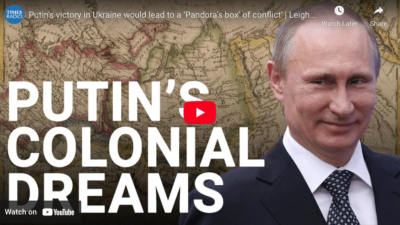A Trump sell-out of Ukraine to give President Putin everything he wants looks the likeliest outcome of the 15 August Alaska summit. The costs of any such sell-out for the rest of the world – and the US itself – would be high.
I updated this post with an additional paragraph in November 2025.
The images of Steve Witkoff, President Trump’s envoy, shaking hands with Vladimir Putin on 6 August in Moscow were familiar. High-ceilinged rooms, gilded everything, warm handshakes. Afterwards, a Kremlin spokesman said the talks had been “constructive”. Russian state media announced that Putin had “conveyed some signals to the United States on the Ukrainian issue.” “Corresponding signals,” they said, “were also received from President Trump.”

Dark clouds over Kyiv
A Trump sell-out? Or a U-turn?
As Witkoff left Moscow, Trump announced an additional 25% tariff on India, “in response to its continued purchase of Russian Federation oil”. A White House “Fact Sheet” announced that “The Russian Federation’s actions in Ukraine pose an ongoing threat to US national security”.
President Trump’s announcement of additional tariffs on India, linked to Russia’s actions in Ukraine, felt like a U-turn in US policy. For the first time since January, the US President had announced measures – albeit not coming into effect until later – that would cause Moscow real pain.
Many observers had been saying for years that Russia’s invasion of Ukraine threatened US as well as European security. The title of the Fact Sheet: “President Donald J Trump Addresses Threats to the United States by the Government of the Russian Federation” – seemed significant.
The problem was that Trump had consistently taken Russia’s side in the conflict. In February, US Defense Secretary Pete Hegseth said Ukraine would never regain its pre-2014 borders, or join NATO. This bowed to key Russian demands before negotiations even started. The same month saw Trump calling President Zelensky of Ukraine a “dictator” and the slow-motion car-crash of Trump’s shouting match with Zelensky in the Oval Office. Also in February, the US refused to condemn Russia at the United Nations for invading Ukraine, voting alongside Russia and North Korea.
Trump’s frustration with Putin
As Russia ramped up its bombing campaign and refused to implement a ceasefire, Trump began to express frustration with Putin. In July, Trump said he would impose 100% secondary sanctions targeting Russia’s trade partners if a peace deal wasn’t reached by 1 September. He said he would “massively supply” Ukraine with arms. Then, unpredictable as ever, he brought the tariff deadline forward to 8 August, just after Witkoff’s meeting with Putin. The fact that deadline has now passed without any action whatsoever recalls Douglas Adams’ famous quote: “I love deadlines. I love the whooshing noise they make as they go by.”
For 24 hours after Witkoff’s visit, it was possible to hope that Trump’s announcement of an additional 25% tariff on India, plus the White House statement that Russia’s actions in Ukraine posed a threat to US security, could be a first, unprecedented step towards the US putting pressure on Russia to stop the war. Then Trump announced a 15 August summit with Putin in Alaska. Sadly, every indication points to Trump preparing to sell out Ukraine.
A Trump sell-out of Ukraine – and the US?
Trump’s unpredictability-as-a-negotiating-tactic making forecasting of his actions hazardous. But at present, all signs point towards a sell-out. Trump has referred to “great progress” in Witkoff’s talks with Putin. Ahead of the 15 August summit, Trump said: “There will be some swapping of territories, to the betterment of both”. The new tariffs on India – not 100% as forecast, but a total of 50% – do not come into effect until 27 August – well after the Putin-Trump summit.
Since January, the Trump administration has blown hot and cold about Europe’s role in solving the Ukraine war. JD Vance said on 10 August: “If [Europe cares] so much about this conflict, you should be willing to play a more direct and more substantial way (sic) in funding this war yourself”. When the UK and EU have sought to play a role, however, the US has rubbished such efforts. In March, Steve Witkoff dismissed European plans for an international force to support a ceasefire in Ukraine as “a posture and a pose”.
In all his contacts with Russia, Trump has seemed to focus less on principles of geopolitical stability and security than on vague economic deals that might be possible if only the war could be ended and relations with Russia normalised. Moscow is making the most of that: Russia has announced a delegation to the 15 August Alaska summit that includes Finance Minister Siluanov and the head of the Russian Direct Investment Fund, Kirill Dmitriev. Moscow talked on 14 August about the “enormous, untapped potential for trade and economic co-operation” between the US Russia. This is music to Trump’s ears.
The risk is that, in his eager pursuit of a deal – any deal – Trump will back “peace” proposals that give Russia everything it wants. That could even include the US formally recognising Russian sovereignty over Crimea, which Russia occupied in 2014. Such recognition of a territory seized by force would embolden Russia to launch future attacks on Ukraine and other neighbours. It would incentivise all other countries with ambitions on nearby territories, from China to Venezuela, to launch fresh wars. It would also drive a coach and horses through nuclear non-proliferation efforts. The clear message would be: unless you get nuclear weapons, your nuclear-armed neighbour can do whatever the hell they want. All countries – including the US – would live in a more dangerous world. All would need massively to boost defence budgets to deter future aggression.
By selling out Ukraine, President Trump would be selling out the United States, too.
As Margus Tsahkna, Estonia’s foreign minister, said, “If borders can be changed by force, none of us are safe… Sovereignty and territorial integrity are the cornerstones of global stability.”
The US should put pressure on Russia
Leaders such as Germany’s Chancellor Friedrich Merz have urged the US to implement tougher sanctions. “Putin only acts under pressure,” Merz said. This is 100% correct.
There are plenty of things Washington could, and should, do now. Action against the leaky, dangerous, uninsured shadow fleet that transports Russia’s oil to markets. Secondary sanctions on banks and oil refineries in countries that facilitate trade in Russian oil. Providing more weapons to help Ukraine turn the tide of the war. None of this has happened.
Rather, the risk is that Trump will “agree” with Putin a “deal” that requires Ukraine to give up land. If Ukraine declines to do so, the US may put pressure on Ukraine to agree. The US has done this several times since January already – cutting off arms supplies to, and intelligence co-operation with, Ukraine – without ever putting pressure on Russia.
US Vice President JD Vance said on 10 August that the 15 August Trump-Putin summit would be a “major breakthrough for American diplomacy”. It’s hard to see how giving the aggressor everything it wants can be a diplomatic triumph.
No wonder Ukraine has been saying that it will not accept any agreement made without it – especially one that legitimises Russia’s occupation of its sovereign territory. No wonder President Zelensky has been calling European leaders, seeking to firm up support for that line. They should support Ukraine, militarily, politically and economically – in the interests of both European and US security.
Will Putin wind Trump around his little finger again?
Putin has an impressive history of getting everything he wants from Trump each time they talk. The announcement of an in-person summit on US territory, sadly, makes it look likely that the Russian President has again wound his US counterpart around his little finger – and will achieve his war goals without making any meaningful concessions. I hope I’m proved wrong. A bad deal for Ukraine – particularly if the US recognises Russian sovereignty over even one square inch of Ukraine’s territory – will create a more dangerous world. It will also – as the White House’s own fact sheet implied – compromise the security of the United States itself.
A Trump sell-out? November update
The outcome of the Alaska summit in August was as dismal as I foresaw. President Trump treated President Putin like royalty and came away, as so often apparently showing strong support for Russian positions. This led to massive pressure from the UK and EU countries to try and move Trump towards a more balanced approach. This pressure appeared to bear fruit. A planned further Trump-Putin summit, in Hungary, was cancelled. Most significantly, in late October President Trump announced new sanctions on Russian oil producers. It’s too early at the time of writing (mid-November 2025) to be sure how effective these will be, or whether Putin will succeed in getting them dropped with some vague promise. But for now, they look like a welcome step in the right direction; and could, potentially, make it harder for Putin to finance his totally unnecessary war.
What to do next
For more about Russia-Ukraine, see my book “Lessons in Diplomacy: Politics, Power and Parties“. Chapter 4 is called “How to understand Putin’s war on Ukraine”.







